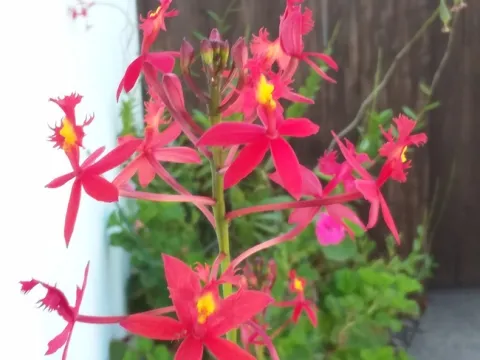
Epidendrum Orchid
By Pollly Nelson UCCE Master Gardener
Orchidaceae family, Epidendrum ibaguense (radicans)
Planting Zone: USDA 10-11, Sunset 17, 21-24 outside
Size: Erect stems are 2-4 feet high; plant can be 3-4 feet in width
Bloom season: Almost continuously in warm weather.
Exposure: Medium to high indirect light. Leaves turn brownish-bronze with too much light; too little light can result in leggy plants with few blooms.
Water needs: Adaptable to mostly drought tolerant once established but needs at least weekly watering in warm season and less often in cooler weather. The plant will enjoy more water if available, but dislikes standing in water or drying out completely.
Humidity: A minimum of 50% with adequate air movement.
Description: Epidendrums are good starter orchid for first-time orchid growers. They can be kept outdoors where frost is not a factor and can adapt to a variety of light situations. Butterflies are attracted to the red, yellow, fuchsia, orange, or lavender flowers, while deer are not. Flowers grow on top of long stems originating from the base of the plant and each blossom of 20-30 tiny individual frilly flowers are clustered together. The oblong, evergreen leaves are leathery in texture and medium- dark-green in color. Use stakes or tomato cages to support vertical growth without sprawl. Propagate easily by cutting below the aerial roots, and planting in well-draining soil (in ground or pot) with fine-to-medium bark mixed with perlite for adequate drainage. Clay pots will require more water; plastic pots with drain hole can be used, as well as raised beds and planters if frost is not an issue. Epidendrums do not like salt spray at the coast. Grow in an enclosed courtyard or a greenhouse if needed. Fertilize with a balanced 20-20-20 orchid fertilizer, half-strength, weekly during the blooming season.

